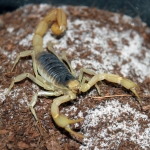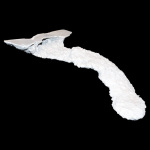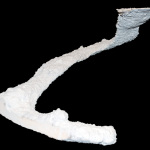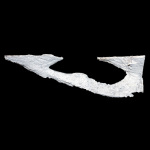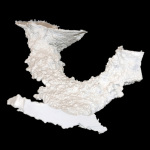Arizona Hairy Desert Scorpion (Hadrurus arizonensis)
For full details see Hembree et al. (2012) in Palaeontologia Electronica.
Description of Organism
- Largest extant scorpion in North America, reaching up to 14 cm in length.
- Long, narrow pedipalps.
- Feeds on other invertebrates as well as small rodents, lizards, and snakes.
- Brown setae (“hairs”) allow it to feel vibrations in soil.
- Inhabits regions with arid to semi-arid climates.
Published Descriptions of Organism
Hembree et al. (2012)
- Scorpions (Class Arachnida) are a diverse group of terrestrial arthropods consisting of over 1700 described extant species within 13 families (Sissom, 1990). The morphology of scorpions is characterized by eight legs, a pair of grasping claws or pedipalps, and a narrow, segmented tail ending in a venomous barb (Hjelle, 1990). The body of a scorpion can be divided into three parts, the cephalothorax (head), mesosoma (abdomen), and metasoma (tail) (Hjelle, 1990). The cephalothorax consists of the carapace, eyes, chelicerae, pedipalps, and four pairs of walking legs. The pedipalps are used for prey immobilization, defense, and sensory purposes. The mesosoma consists of seven segments each covered by a sclerotosed plate. Segments 3–7 have a pair of spiracles which are the openings for the book lungs. The metasoma consists of five segments and a sixth that bears the telson (sting). Modern scorpions are very similar to Paleozoic scorpions; despite changes in locomotion and respiration needed for the move from aquatic to terrestrial habitats, the basic scorpion body plan has been unchanged in 425 million years (Sissom, 1990). Neither is there much difference in external morphology among modern and fossil scorpions from different habitats; scorpions from tropical rainforests are similar to those from deserts (Hjelle, 1990; Sissom, 1990).
- Scorpions are present on all continents with the exception of Antarctica and inhabit a wide range of environments and climates including high elevation mountains, arid deserts, tropical rainforests, intertidal zones, and caves (Sissom, 1990). Most scorpions prefer temperatures from 20–37° C, although some can survive extremes from -31° C up to 50° C (Hadley, 1990). Scorpions are nocturnal and fossorial, hiding in burrows, under rocks, in leaf litter, or under tree bark during the day to avoid detection by predators (Polis, 1990). Scorpions are opportunistic predators of small arthropods and insects, although larger species will hunt small reptiles and mammals (McCormick and Polis, 1990). In terms of density, diversity, and biomass, scorpions are one of the most important and successful predators in many modern habitats (Polis, 1990; McCormick and Polis, 1990). Scorpions have a very low metabolic rate, and some species may survive for up to a year without food while others can live indefinitely without water obtaining all of their required moisture from prey animals (Polis, 1990; Lighton et al., 2001). In general, scorpions have a long lifespan compared to other arthropods, up to 25 years in some species (Polis and Sissom, 1990). While most scorpions are solitary, some are communal and all female scorpions show some degree of maternal care with the young remaining with their mothers for up to several months after hatching (Polis and Sissom, 1990).
- All modern scorpion populations are characterized by low levels of surface activity while burrowing scorpions spend the majority of their lives in their burrows (Hadley and Williams, 1968; Tourtlotte, 1974; Polis, 1980; Bradley, 1982; Warburg and Polis, 1990). Obligate fossorial scorpions, which represent an extreme end member of the group, spend all of their lives in their burrows with the exception of time spent in courtship, mating, and the dispersal of newborn (Williams, 1966; Koch, 1978; Shachak and Brand, 1983). But even burrowing scorpions that actively hunt on the surface spend most of their time below the surface. Many scorpions only hunt 20–50% of all possible nights and are only on the surface for an average of 4 hours (Hadley and Williams, 1968; Tourtlotte, 1974; Polis, 1980; Bradley, 1982; Polis, 1990). This amounts to 90–95% of their existence spent within their burrows (Polis, 1990). This aspect of scorpion behavior highlights the importance of burrows to their ecology and evolutionary history.
- The majority of burrowing scorpions stay within 1 m of their burrow entrance when on the surface (Polis, 1990) although individuals may forage at greater distances, up to 8 m in extreme examples (Polis et al., 1986). Some species will return to previously constructed burrows even after traveling relatively large distances suggesting that some are capable of homing, but the exact mechanism for this behavior is not well understood (Polis, 1990). The value of homing behaviors is understandable and considerable selective pressure would have favored its evolution in scorpions. For example, with such low metabolic rates, burrow construction is energetically costly to scorpions especially for those that are ambush predators and are stationary most of the time (Polis, 1990; White, 2001). Some scorpions may excavate 200–400 times their body weight in sediment during burrow construction (Shorthouse and Marples, 1980).
- Burrows provide scorpions a refuge from predators and from potentially harmful surface conditions such as extreme temperatures and humidity (Newlands, 1969; Polis, 1990). Extreme temperatures (35+° C) are moderated only 5 cm below the surface, relative humidity is much higher, and rates of exapotranspiration are much lower (Polis, 1990).The burrow is used for almost all of the scorpion’s life activities including birth, maternal care, molting, feeding, and in some species mating (Polis, 1990). Burrows also provide a protective environment for the time after molting; burrowing scorpions will in fact only molt within a burrow (Polis, 1990). While many burrowing scorpions forage away from the entrance of their burrows, the remains of prey animals within burrows suggests that even those that forage on the surface carry prey back to the burrow for feeding (McCormick and Polis, 1990).
- Different scorpion species use a combination of chelae, chelicerae, legs, and even the tail to loosen and remove soil and to compact burrow walls (Williams, 1966; Eastwood, 1978; Harrington, 1978; Koch, 1978; Shorthouse and Marples, 1980; Polis et al., 1986; Polis, 1990; Rutin, 1996; White, 2001). These anatomical structures are typically adapted to specific substrate characteristics such as hardness and particle size (Polis, 1990). Studies of some scorpions have shown that those that inhabit hard soils have short but stout legs, setae, and chelicerae while those in looser soils have thinner and longer structures (Lamoral, 1979). Field studies have shown that scorpions construct an array of burrow types. Some consistently use the burrows of other animals such as spiders or rodents (Koch, 1978). Simple burrows are enlarged natural openings beneath rocks or logs which may be horizontal to or perpendicular to the surface (Polis, 1990). Most scorpion burrows are constructed at a 20–40° angle to the surface and are often relatively straight or slightly curved (Williams, 1966; Shorthouse and Marples, 1980; Polis et al., 1986). Burrows of some species may form loose spirals as they descend (Koch, 1978; Shorthouse and Marples, 1980; Polis et al., 1986; White, 2001). Some burrows may contain enlarged chambers at the entrance or terminus (Polis, 1990). The burrows may have two or more entrances or tunnels, and the entryways are oval in cross section, wider than they are high (Polis, 1990). The burrow entrances are typically flat on the bottom and crescent-shaped on top conforming to the cross-sectional shape of the scorpion’s body (Polis, 1990). Most scorpion burrows are 15–50 cm deep, although some Hadrurus specimens have been found up to 2 m deep (Stahnke, 1966; Polis, 1990). The depth of the burrow appears to be a function of the age and sex of the scorpion; younger age groups and males construct shallower burrows than adult females (Polis, 1990). Some studies have also shown that burrow depth varies in relation to average rainfall, where burrows are deeper in arid regions than in wetter regions (Koch, 1978).
- Hadrurus arizonensis, commonly referred to as the giant desert hairy scorpion, is one of nine species of the genus Hadrurus and the largest extant scorpion in North America reaching up to 14 cm in length (Hjelle, 1990). Hadrurus arizonensis is characterized by two long and narrow pedipalps and brown setae (“hairs”) that cover its body which allow the scorpion to detect vibrations in the soil (Hjelle, 1990). They are solitary animals and like most other scorpions, H. arizonensis is a nocturnal predator (Bub and Bowerman, 1979). The large size of H. arizonensis allows it to feed on a variety of invertebrates including other scorpions as well as small vertebrates such as rodents, lizards, and snakes (Bub and Bowerman, 1979). They inhabit regions with semi-arid to arid climates with semi-arid to arid climates and are especially adapted to hot and dry conditions (Hadley, 1970a, 1974, 1990). In the United States, H. arizonensis is distributed throughout the Sonora and Mojave deserts (Sissom, 1990). They are usually found in low elevation valleys where they construct burrows that can be up to 2.5 m deep although there has been limited research on how these burrows are constructed or the details of their morphology (Hadley, 1970b; Bub and Bowerman, 1979; Tallarovic et al., 2000).
Burrowing Technique
Hadrurus arizonensis burrows by direct excavation using the first three walking legs to both kick and drag sediment particles to the surface. The scorpion initiates burrowing by kicking loose sediment behind its body with the first two pairs of walking legs. These legs are moved rapidly, with enough force to move sand-sized grains 5-15 cm. As the scorpion begins to form a shallow depression, the third pair of walking legs is also used to excavate sediment in a similar manner. The pedipalps have not been observed to be used to excavate or manipulate sediment, regardless of location of burrow within experimental enclosure. When encountering large particles, the scorpion gathers them below its body and then drags the pile of course-grained sediment out of the excavation area. This method is used more frequently with increasing depth of the burrow.
Burrowing Technique Videos
Burrowing Behavior
Specimens of H. arizonensis begin burrow construction within 24-48 hours of placement into experimental enclosures. Before burrowing, the scorpions explore their enclosure, moving systematically throughout the entire terrarium. After burrowing begins in most experiments, 1-3 burrows are started but abandoned soon after excavation commences, typically within 12-24 hours. These burrows form 1-4 cm deep pits. After construction of the final burrow begins, it typically only takes 4-6 hours for the burrow to be completed. There is no consistent placement of burrow openings within experimental enclosures. Simple burrows are produced in all observed sediment types, whereas more complex burrows are produced in sediments with moderate to high clay content and sediment density. The burrows serve as temporary shelters and permanent dwellings. The burrow openings are used as prey ambush sites; more complex burrows are used to trap prey below the surface.
Trace Morphology
Hadrurus arizonensis produced four distinct burrow morphologies as well as cross lamination of loose sediment during burrow excavation; examples of each are shown below. Each photo is linked to an information page about the specific burrow architecture shown.
